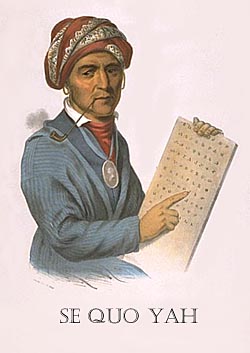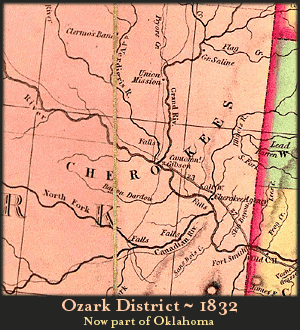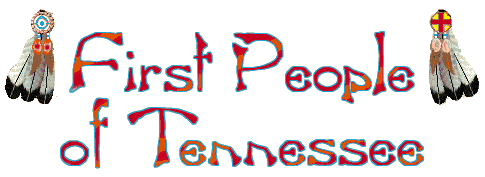Since the Cherokee had no written language,
the White man’s records are of utmost importance in Cherokee genealogy
(i.e. the citizenship rolls and censuses).
Additionally, Sequoyah’s
syllabary is culturally and historically important and
does provide some valuable help with records. Beginning in about 1822, many legal
documents were signed by Cherokee using the syllabary.
The advantage is a beginning of
standardization of names, and the basis for
accurate translation of the names into English.
Also, the beginning of the publication of the Cherokee Nation newspaper,
using the syllabary provides much 19
th century information.

Sequoyah, (aka Sequaya, Se Quo Yah, or
George Guess)
with his syllabary and a
silver Indian Peace Medal.
Generally, the U.S. government’s
Cherokee records are available through the National Archives
(
NARA) but perhaps not at all regional facilities. All
the Dawes Records are located at
the
Southwest Regional Office
Fort Worth, Texas.
In later historic times, starting 1777, the Cherokee primarily inhabited
southwest North Carolina, southeast Tennessee, northern Georgia, and northern Alabama. In 1777, the Cherokee gave
up all their claims to South Carolina, and withdrew to west of the Blue Ridge Mountains.
(See our
Cherokee
Nation of Indians page and map showing the greatest extent of the pre-1777 Cherokee
Nation.)
A few Cherokee started moving west, first to what is now Missouri,
where they did not stay long because of a series of earthquakes there (New Madrid Earthquake,
Missouri Territory). Most of these
moved to what is now Arkansas, or returned east.
By 1817, there were about 5,000 Cherokee in what is now Arkansas.
The states of Georgia and Tennessee wanted the remainder to leave. There was a treaty
ceding lands in Georgia and Tennessee in return for an equal amount of
land in Arkansas Territory, the first Indian Territory.” This became
known as the Cherokee Cession of 1817. The land was located between
the
Arkansas and White Rivers.
The cession was extinguished by the U.S.
at the time of the
New Echota Treaty,
1835, which led directly to
removal, “The Trail of Tears.”
This is to say, until 1839,
most of the remaining Cherokee lived
east of the Mississippi. After 1839,
most probably lived west of the
river.


A much smaller number remained in the Old Cherokee
Nation east of the Mississippi, hence the two modern bands of the Cherokee, Western and Eastern.
((“Cherokee Nation East” is a modern concept, not used by the Cherokee
people at the time. In early historic times (1755), the divisions were
Over Hill Towns, Valley Towns, Middle Towns, Keowee Towns, Out Towns, and Lower Towns, all
referencing the general location of the Cherokee towns.))
The Cherokee
Nation after the Trail of Tears was divided into several different groups. Those who removed *prior*
to the Trail of Tears were known as *Old Settlers,* (some of who went into Texas -- to be known as the
Texas Cherokee), the Emigrant Cherokee, and the Treaty Party.
((*Texas Cherokee* is a modern convention, not used by the Cherokee.
Those who came to Texas were known as Diwali’s band for the leader of that
group. ”Offically” they were present from about 1819 (a small band) and 1840
(a larger group invited by Sam Houston and Stephen F. Austin to aid in the
Texans revolt against Mexico -- the Cherokee were expected to buffer the
immigrant Texicans from the Comanche and Kiowa who believed that what is now
Texas was their hunting grounds. There are remnant descendants of Diwali’s
band and the subsequent “buffer” group who still live in Texas and Mexico,
but they are not recognized by any of the Federal tribes as a tribe.
The Emigrants and the Treaty
Party are basically the same group, although
the Treaty Group (re: New Echota Treaty of 1835), are the active political
group who were blamed for Removal.))
The *Old Settlers* (mostly settling in
Arkansas, between 1817 and 1835) removed so as to get away from the
White Intruders in the Old
Cherokee Nation.
This list of Rolls has been gleaned from the Internet.
I have included microfilm numbers if known,
however, these numbers
have not been verified! No books or CDs included. I do not guarantee
that this list is without error and omissions -- and the Rolls may be known with
two (or more) different names. Therefore, I may have them listed here TWICE!
By Fred Smoot
With special thanks to Glen Davis
for the needed corrections and additions!
 List of Rolls
1817 Reservation Roll
List of Rolls
1817 Reservation Roll (those requesting a reservation).
The
1817 treaty allowed
for a six hundred and forty acre life estate per head of household,
which upon the death of the grantee, or abandonment of the land by
the grantee, reverted to the state; microfilm Group 75.
1817 Emigration Roll (1817-1835 Old Settlers) microfilm A21.
1835 Henderson Roll (also called the Trail of Tears roll). 16,000 plus Cherokee residing in
Alabama, Georgia, North Carolina, and Tennessee who were supposed to remove
to Indian Territory under New Echota Treaty of 1835; microfilm T496.
1848 Mullay Roll (resided in North Carolina). 1,517 Cherokee remaining in
North Carolina after removal. Taken as a result of an Act of Congress; microfilm 7RA6.
1851 Old Settlers Roll This is the Roll of those still alive in 1851, who were already
resident in *Oklahoma* by 1839, when the emigrants arrived.
This group was about 1/3 the total Cherokee population in what is
now Oklahoma. Note: it is important to recognize that this census did not include
those “Old Settlers” who remained in Arkansas, Texas, or Mexico; microfilm M-685,
Reel 12.
1851 Siler Roll (Cherokee East of the Mississippi) microfilm 7RA6.
1852 Chapman Roll (Cherokee East of the Mississippi) The Chapman
Roll was taken in 1851 by Alfred Chapman . This roll, which followed almost immediately the Siler Roll,
was a result of many complaints by various
Cherokees of having been omitted by Siler (JWJ) microfilm M-685.
1852 Drennen Roll (Emigrant Cherokee in Indian Territory). This roll was the
first census of the emigrants/new arrivals of 1839. This was the “Trail of Tears”
survivors, or New Echota Treaty Group; microfilm M-685.
1854 Act of Congress Roll (Cherokee East of the Mississippi) microfilm 7RA6.
1860 Census (of whites in Cherokee Nation)
1867 Tompkin Roll microfilm 7RA4.
1867 Census of Cherokee East of the Mississippi microfilm 7A29.
1867 Kern-Clifton Roll of Cherokee Freedmen , January 16, 1867.
1869 Sweatland Roll (resided in North Carolina ) NARA roll, but number not found.
1880 Cherokee Census microfilm 7RA7.
1880 Lipe Roll microfilm 7RA33.
1883 Cherokee Census microfilm 7RA29 Reels 1 & 2.
1883 Cherokee Roll microfilm 7RA56.
1883 Hester Roll (Cherokee East of the Mississippi) microfilm M685.
1886 Cherokee Census microfilm 7RA58.
1890 Cherokee Census microfilm 7RA60.
1890 Cherokee Payment Roll (The Receipt Roll) microfilm 7RA59.
1890 Wallace Roll (of Cherokee Freedmen in Indian Territory)
((Wallace Roll of Cherokee Freedmen in Indian Territory.
These rolls were created because the Cherokee citizenship of many ex-slaves of
the Cherokee in Indian Territory was disputed by the Cherokee tribe. The
establishment of their status was important in determining their right to live on
Cherokee land and to share in certain annuity and other payments, including a
special $75,000 award voted by Congress on October 19, 1888. A series of
investigations was conducted in order to compile the rolls of the Cherokee Freedmen.
These investigations were conducted by John W. Wallace, 1889-1890; Leo E. Bennett,
1891-92; Marcus D. Shelby, 1893; James G. Dickson, 1895-96; and William Clifton,
William Thompson, and Robert H. Kern, 1896-97.))
1893 Cherokee Census microfilm 7RA54.
1894 Starrs Roll microfilm 7RA38.
1896 Old Settlers Payment (for Descendants of Old Settlers) microfilm 7RA34.
1896 Cherokee Census microfilm 7RA19.
 1898-1902 (1914) Dawes Roll
1898-1902 (1914) Dawes Roll
((Rolls of Citizens and Freedmen of the Five Civilized Tribes in Indian Territory
consisting of 634 pages of names. The Dawes Commission was organized in 1893 to accept
applications for tribal enrollment between 1899 and 1907 (some were added as late as
1914), mostly from Indians who resided in the Indian Territory which later became the
State of Oklahoma. Tribal membership entitled qualified individuals to land allotments
from the U.S. Government. These enrollment records were eventually published as the
Dawes Commission, also known as The Five Civilized Tribes, which consisted of the
Cherokee, Choctaw, Chickasaw, Creek and Seminole Tribes.))







